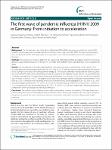The first wave of pandemic influenza (H1N1) 2009 in Germany: From initiation to acceleration
Poggensee, Gabriele
Gilsdorf, Andreas
Buda, Silke
Eckmanns, Tim
Claus, Hermann
Altmann, Doris
Krause, Gérard
Haas, Walter
Background: The first imported case of pandemic influenza (H1N1) 2009 in Germany was confirmed in April 2009. However, the first wave with measurable burden of disease started only in October 2009. The basic epidemiological and clinical characteristics of the pandemic were analysed in order to understand the course of the pandemic in Germany. Methods: The analysis was based on data from the case-based, mandatory German surveillance system for infectious diseases. Cases notified between 27 April and 11 November 2009 and fulfilling the case definition were included in the study. Results: Two time periods with distinct epidemiologic characteristics could be determined: 23,789 cases (44.1%) occurred during the initiation period (IP, week 18 to 41), and 30,179 (55.9%) during the acceleration period (AP, week 42 to 45). During IP, coinciding with school summer holidays, 61.1% of cases were travel-related and one death occurred. Strict containment efforts were performed until week 32. During AP the majority of cases (94.3%) was autochthonous, 12 deaths were reported. The main affected age group shifted from 15 to 19 years in IP to 10 to 14 years in AP (median age 19 versus 15 years; p < 0.001). The proportion of cases with underlying medical conditions increased from 4.7% to 6.9% (p < 0.001). Irrespective of the period, these cases were more likely to be hospitalised (OR = 3.6 [95% CI: 3.1; 4.3]) and to develop pneumonia (OR = 8.1 [95% CI: 6.1; 10.7]). Furthermore, young children (0 to 2 years) (OR = 2.8 [95% CI: 1.5; 5.2]) and persons with influenza-like illness (ILI, OR = 1.4 [95% CI: 1.0; 2.1]) had a higher risk to develop pneumonia compared to other age groups and individuals without ILI. Conclusion: The epidemiological differences we could show between summer and autumn 2009 might have been influenced by the school summer holidays and containment efforts. The spread of disease did not result in change of risk groups or severity. Our results show that analyses of case-based information can advise future public health measures.
Dateien zu dieser Publikation
Keine Lizenzangabe
Verwandte Publikationen
Anzeige der Publikationen mit ähnlichem Titel, Autor, Urheber und Thema.
-
2016-02-18ZeitschriftenartikelVaccine effectiveness in preventing laboratory-confirmed influenza in primary care patients in a season of co-circulation of influenza A(H1N1)pdm09, B and drifted A(H3N2), I-MOVE Multicentre Case–Control Study, Europe 2014/15 Valenciano, Marta; Kissling, Esther; Reuss, Annicka; Rizzo, C.; Gherasim, A.; Horváth, Judit K.; Domegan, L.; Pitigoi, Daniela; Machado, Ausenda; Bella, A.; Paradowska-Stankiewicz, I.; Larrauri, A.; Ferenczi, A.; O´Donell, Joan; Lazar, M.; Pechirra, P.; Korczyńska, M. R.; Pozo, Francisco; Moren, A.Influenza A(H3N2), A(H1N1)pdm09 and B viruses co-circulated in Europe in 2014/15. We undertook a multicentre case–control study in eight European countries to measure 2014/15 influenza vaccine effectiveness (VE) against ...
-
2016-10-13ZeitschriftenartikelImproving influenza virological surveillance in Europe: strain-based reporting of antigenic and genetic characterisation data, 11 European countries, influenza season 2013/14 Broberg, E.; Hungnes, Olav; Schweiger, Brunhilde; Prosenc, Katarina; Daniels, R.; Guiomar, R.; Ikonen, N.; Kossyvakis, A.; Pozo, Francisco; Puzelli, S.; Thomas, I.; Waters, A.; Wiman, Å.; Meijer, AdamInfluenza antigenic and genetic characterisation data are crucial for influenza vaccine composition decision making. Previously, aggregate data were reported to the European Centre for Disease Prevention and Control by ...
-
2013-02-14ZeitschriftenartikelEarly estimates of seasonal influenza vaccine effectiveness in Europe: results from the i-move multicentre case–control study, 2012/13 Valenciano, M.; Kissling, E.We conducted a test-negative case–control study based in five European sentinel surveillance networks. The early 2012/13 adjusted influenza vaccine effectiveness was 78.2% (95% CI: 18.0 to 94.2) against influenza B, 62.1% ...

